
Since 2010, Native Plants have been our mission.
What Cuplet Fern Means to Us.
The Vision of Cuplet Fern Florida Native Plant Society is to increase Florida native plant representation across all landscapes in Seminole and West Volusia.
Cuplet Fern was created in 2010 as a chapter of the Florida Native Plant Society. It was initially suggested to be called Bald Cypress! Rick Ehle, the first President, proposed Cuplet Fern. It was due to him and his study of the plant that our organization received its renowned name.
Cuplet Fern directly serves Seminole and West Volusia. It enjoys supporters across Florida and beyond. Together we conserve, protect, and restore that which is most precious- our native plants.
We are highly active in our region with something going on almost every single week. Come join us; or simply support us through membership and donations.
Cuplet Fern’s Mission
-
The Cuplet Fern Chapter of the Florida Native Plant Society’s mission is to advocate for the native plants and habitats of Seminole and Volusia County by seeking to learn and educate, build community, and expand conservation in our region.
-
Expand our collective knowledge of native plants, landscapes, and habitats in Seminole and Volusia County, including their impact on resilience and sustainability. This includes efforts to understand native plants and the challenges they face, sharing that knowledge with others.
-
Connect enthusiasts, members, students, educators, nurseries, experts, and other stakeholders through outreach, events, and partnerships. This should include both opportunities that bring native plants to the community, such as plant sales, demonstration gardens, bioblitzes, art, and festivals, as well as opportunities such as nursery and school partnerships.
-
Lead and support ongoing conservation efforts in the region, through projects such as partnerships, plant rescues, and resource building for community conservation efforts.
The first Cuplet Fern meeting in 2010!
With Rick Ehle, Permelia Ehle, Estelle Hurwitch, Sherry Williams, Susan Angermeier, Charles Miller, Graham Williams, Shari King, Richard Poole, Christine Brown, Neta Villalobos-Bell, and Gabrielle Milch (among many others).
THE PLANT
Cuplet fern, Dennstaedtia bipinnata, is a naturally occurring rare fern vouchered only from three counties in the United States mainland- all in Florida. Unfortunately, this fern has been thought to be extirpated (locally extinct) in one of these counties; and the two left are both in Central Florida. The plant is, however, grown commercially. The pickiness of this plants preferred natural habitat- wet, mucky areas, partially shady, with a constant source of nearby water- makes it a very rare find in the wild and challenging to grow in urban spaces. Therefore, it has an inherent conservation message tied to it. Dennstaedtia bipinnata has a larger presence in South America and the Carribean; but Florida is lucky to be its home in a few, very special places.
-
To read a short, but highly descriptive excerpt about the cuplet fern species, we recommend the plant genius, Gil Nelson's, book titled 'Ferns of Florida' for arguably the best description readily found on the web. Excerpt below courtesy of Gil Nelson and Google books. Page 75. It's best viewed and read through a tablet or larger screen.
-
The fern is a large, terrestrial, creeping fern 3'-4' in height and is also called the hay scented fern as when the leaves are crushed, they exude a pleasant smell reminiscent of hay. It is called the cuplet fern because of its cup-like indusia- or sori (fern pollen) holding vessels- that are present on the underside of their smooth, large, feather-like leaves. Cuplet fern is a very attractive plant when spotted in the wild. It's very rarely found- one could say that it's the unicorn in the forest. Admire it- take only pictures, leave behind only footprints.
Ferns fall into an ancient lineage of plants that have a different, complex life cycle. They predate the advent of flowering plants by millenia. If you are science-driven, feel free to geek yourself on this educational video courtesy of the literary publication giant, McGraw Hill:
-
Here's a great video that serves as a cursory introduction to the diverse world of ferns and fern allies courtesy of Go Botany and the New England Wildflower Society. Please note that we are a native plant enthusiast group- our hobby includes all types of native plants. Our chapter simply happens to be named after a fern.


